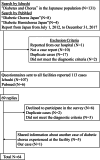Elucidation of the clinical traits of diabetic chorea through a questionnaire survey of people with diabetic chorea from 59 Japanese hospitals
- PMID: 39714319
- PMCID: PMC11970293
- DOI: 10.1111/jdi.14392
Elucidation of the clinical traits of diabetic chorea through a questionnaire survey of people with diabetic chorea from 59 Japanese hospitals
Abstract
Aims: Diabetic chorea refers to sudden involuntary movements developing in people with diabetes mellitus and is known to occur mainly in those with severe hyperglycemia. We conducted a questionnaire survey of case-reporting facilities in Japan to elucidate their clinical characteristics.
Methods: We searched the PubMed and Ichushi databases for case reports published from January 1, 2012, to December 31, 2017, using "diabetes" and "chorea" as keywords, and sent a questionnaire to the reporting institutions.
Results: Data from a total of 64 cases were included in this study. While most cases had severe hyperglycemia at the onset of diabetic chorea, hypoglycemia/improvement of the plasma glucose served as the trigger for the symptom in 14 cases (21.9%). The Early Remission Group (≤6 months) consisted of 39 cases (60.9%), while the Prolonged Partial Remission Group (>6 months) included 25 cases (39.1%). In the Prolonged Partial Remission Group (>6 months), there were more cases with widespread involuntary movement symptoms, a higher number of cases exhibiting typical imaging findings, and a greater incidence of chorea onset after the initiation of antidiabetic treatment, including hypoglycemia.
Conclusions: Most reported cases of diabetic chorea in Japan were elderly persons with type 2 diabetes mellitus and severe hyperglycemia, although there were also some cases in which the symptom developed in the setting of hypoglycemia. It has been suggested that rapid plasma glucose correction and hypoglycemia might be associated with the risk of development and prognosis of diabetic chorea.
Keywords: Clinical features; Diabetic chorea; Questionnaire survey.
© 2024 The Author(s). Journal of Diabetes Investigation published by Asian Association for the Study of Diabetes (AASD) and John Wiley & Sons Australia, Ltd.
Conflict of interest statement
The authors have no conflicts of interests to declare. Takashi Kadowaki and Toshimasa Yamauchi are an Editorial Board member of Journal of Diabetes Investigation and a co‐author of this article. To minimize bias, they were excluded from all editorial decision‐making related to the acceptance of this article for publication.
Approval of the research protocol: This study was approved by the Ethics Review Committee of the University of Tokyo Graduate School of Medicine, and was conducted in conformity with the principles of the Declaration of Helsinki (Ethics review number: 11866‐(4)).
Informed consent: This study was a retrospective analysis, and obtaining consent from the people with diabetic chorea at each institution was difficult, and consent was obtained from those attending or fellow physicians. To protect personal information, we asked that no personally identifiable information be included in the questionnaire responses. An option for opt‐out was posted on the website of the Department of Diabetes and Metabolic Diseases at the Graduate School of Medicine, University of Tokyo, Japan.
Approval date of registry and the registration no. of the study/trial: N/A.
Animal studies: N/A.
Figures
Similar articles
-
Hemichorea after hypoglycemic episodes with negative MRI findings in an elderly woman with poorly controlled type 2 diabetes mellitus: a case report.BMC Neurol. 2019 Jun 15;19(1):131. doi: 10.1186/s12883-019-1334-2. BMC Neurol. 2019. PMID: 31202275 Free PMC article.
-
Chorea-ballism as a manifestation of decompensated type 2 diabetes mellitus.Am J Med Sci. 2007 Mar;333(3):175-7. doi: 10.1097/MAJ.0b013e3180318e34. Am J Med Sci. 2007. PMID: 17496737
-
Chorea due to nonketotic hyperglycemia.Neurol India. 2002 Jun;50(2):213-4. Neurol India. 2002. PMID: 12134194
-
[Diabetic chorea].Brain Nerve. 2014 Feb;66(2):121-8. Brain Nerve. 2014. PMID: 24523310 Review. Japanese.
-
Diabetic striatopathy: an updated overview of current knowledge and future perspectives.J Endocrinol Invest. 2024 Jan;47(1):1-15. doi: 10.1007/s40618-023-02166-5. Epub 2023 Aug 14. J Endocrinol Invest. 2024. PMID: 37578646 Free PMC article. Review.
References
-
- Bedwell SF. Some observations on hemiballismus. Neurology 1960; 10: 619–622. - PubMed
-
- Yahikozawa H, Hanyu N, Yamamoto K, et al. Hemiballism with striatal hyperintensity on T1‐weighted MRI in diabetic patients: A unique syndrome. J Neurol Sci 1994; 124: 208–214. - PubMed
-
- Takamatsu K. Diabetic chorea. Brain Nerve 2014; 66: 121–128. - PubMed


